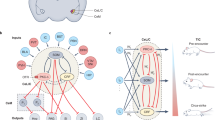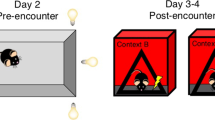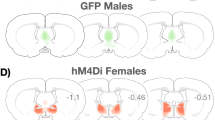Abstract
A battery of tests designed to elicit reactions to a variety of non-painful threat stimuli was used to study the effects of chlordiazepoxide (5–20 mg/kg), diazepam (1–5 mg/kg) and midazolam (1–10 mg/kg) on the defensive repertoire of wild Rattus rattus. The most consistent effect of benzodiazepine treatment, across compounds and tests, was a marked reduction in defensive threat and attack behaviors, with midazolam effective over a wider range of situations. In contrast, effects on freezing and flight reactions were more variable, differing substantially as a function of stimulus context. The general profile of observed changes in defense cannot be explained in terms of either non-specific behavioral suppression or a global reduction in defensiveness. Rather, our findings suggest that benzodiazepines may primarily induce a shift within the defense repertoire.
Similar content being viewed by others
References
Avis HH (1974) The neuropharmacology of aggression: a critical review. Psychol Bull 81:47–63.
Baxter BL (1964) The effect of chlordiazepoxide on the hissing response elicited via hypothalamic stimulation. Life Sci 3:531–537.
Beattie CW, Chernov HI, Bernard PS, Glenny FH (1969) Pharmacological alteration of hyperreactivity in rats with septal and hypothalamic lesions. Int J Neuropharmacol 8:365–371.
Beattie IA, Berry PA, Lister RE (1970) Methods for detecting anti-anxiety drugs using baboons (Papio cynocephalus). Br J Pharmacol 38:460P
Blanchard RJ, Blanchard DC (1977) Aggressive behavior in the rat. Behav Biol 21:197–224.
Blanchard DC, Blanchard RJ (1984) Affect and aggression: an animal model applied to human behavior. In: Blanchard RJ, Blanchard DC (eds) Advances in the study of aggression, vol I. Academic Press, New York
Blanchard RJ, Blanchard DC (1987) An ethoexperimental approach to the study of fear. Psychol Rec 37:305–316.
Blanchard DC, Blanchard RJ (1988) Ethoexperimental approaches to the biology of emotion. Annual Rev Psychol: 39. Annual Reviews, Palo Alto, USA
Blanchard RJ, Blanchard DC, Takahashi T, Kelley M (1977) Attack and defensive behaviour in the albino rat. Anim Behav 25:622–634.
Blanchard DC, Blanchard RJ, Lee EMC, Williams G (1981a) Taming of the wild Norway rat following lesions in the basal ganglia. Physiol Behav 27:995–1000.
Blanchard DC, Williams G, Lee EMC, Blanchard RJ (1981b) Taming of wild Rattus norvegicus by lesions of the mesencephalic gray. Physiol Psychol 9:157–163.
Blanchard RJ, Kleinschmidt CK, Flannelly KJ, Blanchard DC (1984) Fear and aggression in the rat. Aggress Behav 10:309–315.
Blanchard RJ, Flannelly KJ, Blanchard DC (1986a) Defensive behaviors of laboratory and wild Rattus norvegicus. J Comp Psychol 100:101–107.
Blanchard RJ, Blanchard DC, Flannelly KJ, Hori K (1986b) Ethanol changes patterns of defensive behavior in wild rats. Physiol Behav 38:645–650.
Blanchard DC, Hori K, Rodgers RJ, Hendrie CA, Blanchard RJ (1988) Differential effects of 5HT1a agonists and benzodiazepines on defensive patterns in wild Rattus rattus. In: Bevan P, Olivier B, Archer T (eds) Behavioral Pharmacology of 5-HT. (in press)
Blyther S, Marriott AS (1969) The effects of drugs on the hyperreactivity or rats with bilateral anterior hypothalamic lesions. Br J Pharmacol 37:507P-508P
Cameron DB, Blampied NM (1980) Rat's reactions to a predator: modification by chlordiazepoxide. NZ Psychol 9:9–13.
Chance MRA, Silverman AP (1964) The structure of social behaviour and drug action. In: Steinberg H, de Reuck AVS (eds) Animal behaviour and drug action. Churchill Livingstone. London, pp 65–79.
Christmas AJ, Maxwell DR (1970) A comparison of the effects of some benzodiazepines and other drugs on aggressive and exploratory behaviour in mice and rats. Neuropharmacology 9:17–29.
Coutinho CB, King M, Carbone JJ, Manning JE, Boff E, Crews T (1971) Chlordiazepoxide metabolism as related to the reduction in aggressive behaviour of cynomolgus primates. Xenobiotica 1:287–301.
Dantzer R (1977) Behavioural effects of benzodiazepines: a review. Biobehav Revs 1:71–86.
File SE (1987) The search for novel anxiolytics. TINS 10:461–463.
Goldberg ME (1970) Pharmacologic activity of a new class of agents which selectively inhibit aggressive behaviour in rats. Arch Int Pharmacodyn Ther 186:287–297.
Graeff FG, Brandao ML, Audi EA, Schultz MTB (1986) Modulation of the brain aversive system by GABAergic and serotonergic mechanisms. Behav Brain Res 21:65–72.
Heise GA, Boff E (1961) Taming action of chlordiazepoxide. Fed Proc 20:393.
Heuschele WP (1961) Chlordiazepoxide for calming zoo animals. J Am Vet Med Assoc 139:996.
Hoffmeister F, Wuttke W (1969) On the actions of psychotropic drugs on attack- and aggressive-defensive behaviour of mice and cats. In: Carattini S, Sigg EB (eds) Aggressive behaviour. Excerpta Medica, Amsterdam, pp 273–280.
Horovitz ZP, Furgiuele AR, Brannick LJ, Burke JC, Craver BN (1963) A new chemical structure with specific depressant effects on the amygdala and on the hyper-irritability of the “septal rat”. Nature 200:369–370.
Irwin W, Kinohi R, Van Sloten M, Workman MP (1971) Drug effects on distress-evoked behaviour in mice: methodological and drug class comparisons. Psychopharmacologia 20:172–185.
Kemble ED, Blanchard DC, Blanchard RJ, Takushi R (1984) Taming in wild rats following medial amygdaloid lesions. Physiol Behav 32:131–134.
Krsiak M (1975) Timid singly-housed mice: their value in prediction of psychotropic activity of drugs. Br J Pharmacol 55:141–150.
Krsiak M (1979) Effects of drugs on behaviour of aggressive mice. Br J Pharmacol 65:525–533.
Krsiak M, Sulcova A, Tomasikova Z, Dlohozkova N, Kosar E, Masek K (1981) Drug effects of attack, defense and escape in mice. Pharmacol Biochem Behav [Suppl 1] 14:47–52.
Krsiak M, Sulcova A, Donat P, Tomasikova Z, Dlohozkova N, Kosar E, Masek K (1984) Can social and agonistic interactions be used to detect anxiolytic activity of drugs. In: Miczek KA, Kruk MR, Olivier B (eds) Ethopharmacological aggression research. Liss, New York, pp 93–114.
Langfeldt T, Ursin H (1971) Differential action of diazepam on flight and defense behaviour in the cat. Psychopharmacologia 19:61–66.
Lister RE, Beattie IA, Berry PA (1971) Effects of drugs on social behaviour of baboons. In: Vinar O, Votava Z, Bradley PB (eds) Advances in neuropsychopharmacology. North-Holland, London, pp 299–303.
Malick JB (1970) Effects of selected drugs on stimulus-bound emotional behaviour elicited by hypothalamic stimulation in the cat. Arch Int Pharmacodyn Ther 186:137–141.
Manning FJ, Elsmore TF (1972) Shock-elicited fighting and delta 9-tetrahydrocannabinol. Psychopharmacologia 25:218–228.
Miczek KA (1974) Intraspecies aggression in rats: effects of d-amphetamine and chlordiazepoxide. Psychopharmacologia 39:275–301.
Miczek KA (1987) The psychopharmacology of aggression. In: Iversen LL, Iversen SD, Snyder SH (eds) Handbook of psychopharmacology, vol 19. Plenum Press, New York, pp 183–328.
Miczek KA, Barry H (1976) Pharmacology of sex and aggression. In: Glick SD, Goldfarb J (eds) Behavioral pharmacology. Mosby, St. Louis, pp 176–257.
Miczek KA, Krsiak M (1979) Drug effects on agonistic behaviour. Adv Behav Pharmacol 2:87–162.
Mos J, Olivier B (1987) Pro-aggressive actions of benzodiazepines. In: Olivier B, Mos J, Brain PF (eds) Ethopharmacology of agonistic behavior in animals and humans. Nijhoff, Dordrecht, pp 187–206.
Mos J, Olivier B, van der Poel AM (1987) Modulatory actions of benzediazepine receptor ligands on agonistic behavior. Physiol Behav 41:265–278.
Murasaki M, Hora T, Oguchi T, Inami A, Ikeda Y (1976) Action of enpiprazole on emotional behaviour induced by hypothalamic stimulation in rats and cats. Psychopharmacologia 49:271–274.
Panksepp J (1971) Drugs and stimulus-bound attack. Physiol Behav 6:317–320.
Pieri L (1983) Preclinical pharmacology of midazolam. Br J Clin Pharmacol 16:17S-27S
Poole TB (1973) Some studies on the influence of chlordiazepoxide on the social interaction of golden hamsters (Mesocritcetus auratus). Br J Pharmacol 48:538–545.
Quenzer LF, Feldman RS, Moore JW (1974) Toward the mechanism of the antiaggression effects of chlordiazepoxide in rats. Psychopharmacologia 34:81–94.
Randall LO (1960) Pharmacology of methaminodiazepoxide. Dis Nerv Syst 21:7–10.
Randall LO, Schallek W (1967) Pharmacological activity of certain benzodiazepines. In: Efron DH (ed) Psychopharmacology: a review of progress 1957–1967. United States Public Health Service Pub. No. 1836, pp 153–171
Randall LO, Schallek W, Heise GA, Keith EF, Bagdon RE (1959) The psychosedative properties of methaminodiazepoxide. J Pharmacol Exp Ther 129:163–171.
Robichaud RC, Goldberg ME (1974) Pharmacological properties of two chlordiazepoxide metabolites following microsomal enzyme inhibition. Arch Int Pharmacodyn Ther 211:165–173.
Rodgers RJ (1981) Drugs, aggression and behavioral methods. In: Brain PF, Benton D (eds) Multidisciplinary approaches to aggression research. Elsevier/North-Holland, Amsterdam, pp 325–340.
Rodgers RJ, Waters AJ (1985) Benzodiazepines and their antagonists: a pharmacoethological analysis with particular reference to effects on “aggression”. Neurosci Biobehav Rev 9:21–35.
Schallek W, Kuehn A, Jew N (1962) Effects of chlordiazepoxide (Librium) and other psychotropic agents on the limbic system of the brain. Ann NY Acad Sci 96:303–314.
Scheckel CL, Boff E (1967) Effects of drugs on aggressive behaviour in monkeys. In: Brill H, Cole JO, Deniker P, Hippius H, Bradley PB (eds) Neuropsychopharmacology. Excepta Medica, Amsterdam, pp 789–795.
Senault B (1970) Comportement d'agressivite intraspecifique induit par l'apomorphine chez le rat. Psychopharmacologia 18:271–287.
Siegel S (1956) Nonparametric statistics for the behavioral sciences. McGraw Hill, New York
Sofia RD (1969) Effects of centrally-active drugs on four models of experimentally-induced aggression in rodents. Life Sci 8:705–716.
Stark P, Henderson JK (1966) Differentiation of classes of neurosedatives using rats with septal lesions. Int J Neuropharmacol 5:385–389.
Takahashi L, Blanchard RJ (1982) Attack and defense in laboratory and wild Norway and black rats. Behav Proc 7:49–62.
Tedeschi DH, Fowler PJ, Miller RB, Macko E (1969) Pharmacological analysis of footshock-induced fighting behaviour. In: Garattini S, Sigg EB (eds) Aggressive behaviour. Excerpta Medica, Amsterdam, pp 245–252.
Treit D (1985) Animal models for the study of anti-anxiety agents: a review. Neurosci Biobehav Rev 9:203–222.
Treit D, Lolordo VM, Armstrong DE (1986) The effects of diazepam on “fear” reactions in rats are modulated by environmental constraints on the rat's defensive repertoire. Pharmacol Biochem Behav 25:561–565.
Yoshimura H, Ogawa N (1984) Pharmaco-ethological analysis of agonistic behaviour between resident and intruder mice: effects of psychotropic drugs. Folia Pharm Japonica 84:221–228.
Author information
Authors and Affiliations
Rights and permissions
About this article
Cite this article
Blanchard, D.C., Hori, K., Rodgers, R.J. et al. Attenuation of defensive threat and attack in wild rats (Rattus rattus) by benzodiazepines. Psychopharmacology 97, 392–401 (1989). https://doi.org/10.1007/BF00439457
Received:
Accepted:
Issue Date:
DOI: https://doi.org/10.1007/BF00439457




